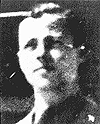Name: Karl Lange
Date of Birth: October 28, 1915
Place of Birth: Hamburg, Germany
 |
1933—39: In 1935 an informer told the police about my secret meetings with a 15–year–old youth, and I was arrested under the criminal code's paragraph 175, which defined homosexuality as an "unnatural" act. Though this law had been on the books for years, the Nazis broadened its scope and used it as grounds for mass arrests of homosexuals. I was released after 15 months but was arrested again in 1937 and imprisoned.
1940—44: In 1943 Hamburg was the target of heavy Allied bombing but the Fuhlsbuettel prison, where I had been held for six years for "security reasons," was not hit. During that period many prisoners were transferred to the Neuengamme concentration camp, but I was in the group sent to the Waldheim prison in Sachsen. I had a nervous breakdown there and entered the prison hospital. I was lucky because as the Allies moved closer, many of the other prisoners were released for combat and died on the front lines.
After the war, Karl found a position in a bank in Hamburg, but he was fired after 18 months when his employer learned that he had been imprisoned under paragraph 175.
EXPLORE FURTHER
 |
Download the Pdf of this activity.
